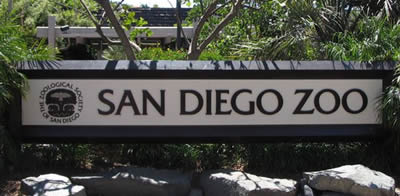|
||
|
|
After The Fishing, Perhaps A Visit To The Zoo?
After The Fishing, Perhaps A Visit To The Zoo? Since 1915, the San Diego Zoo has been a favorite of locals and visitors alike. Located in Balboa Park, the zoo encompasses 100 acres and is home to around 4,000 animals of 800 different species. It is privately operated by the nonprofit Zoological Society of San Diego; ownership of all animals, equipment and other assets rests with the City of San Diego. The Zoo offers a guided tour bus that traverses 75 percent of the park. There is an overhead gondola lift that provides an aerial view of the Zoo and is a quick way to move between opposite ends of the Zoo. Exhibits are often designed around a particular habitat. The same exhibit features many different animals that can be found side-by-side in the wild, along with their native horticulture. Exhibits range from an African rain forest (featuring gorillas) to the Arctic taiga and tundra in the summertime (featuring polar bears). Some of the largest free-flight aviaries in existence are here. Many exhibits are "natural" with invisible wires and darkened blinds (to view birds), and pools and open-air moats (for large mammals). The San Diego Zoo also operates the San Diego Wild Animal Park, which displays animals in an even freer condition than at the Zoo. Some animals are regularly exchanged between the two locales to provide them with a regular change of scenery. The cool, sunny maritime climate is well suited to many plants and animals. Besides an extensive collection of birds, reptiles and mammals, it also maintains its grounds as an arboretum, with a rare plant collection. As part of its gardening effort, it raises some rare animal foods. For example, the Zoo raises 40 varieties of bamboo for the pandas on long-term loan from China, and it maintains 18 varieties of eucalyptus trees to feed its koalas. The Zoo provides society memberships for only a slight premium over the general admission fee, and currently holds over 250,000 members. Society memberships provide year-round re-entrance rights, guest passes and a subscription to the Zoo's magazine ZooNooz. It uses income from its attractions to maintain the animals and support zoological education, science and conservation. For example, it maintains a research division, the department of Conservation for Reproduction of Endangered Species (CRES), literally the last chance for many species. It is extremely active in conservation and species-preservation efforts. Its Center for the Reproduction of Endangered Species (CRES) raises and releases California Condors, Pandas, Tigers, African Black Rhinos and a large number of other endangered species. It employs numerous professional geneticists, cytologists and veterinarians and maintains a cryopreservation facility for rare sperm and eggs. In addition to its normal publicity efforts, and Web page, the Zoo also produced a short TV program for a number of years with Joan Embery. Joan Embery brought various animals to The Tonight Show Starring Johnny Carson and more recently, The Tonight Show with Jay Leno. The Zoo loaned the animals. The Zoo interns only selected graduates of the Veterinary College of the University of California, Davis. Its keepers are unionized. The Zoo literally counts its animals as priceless. It carries the value of its animals and plants at one dollar[1], in accord with customary practice among zoos. A few interesting facts about the San Diego Zoo —
For more information, visit http://www.sandiegozoo.org/zoo/index.html. |
|
 April
2007
April
2007